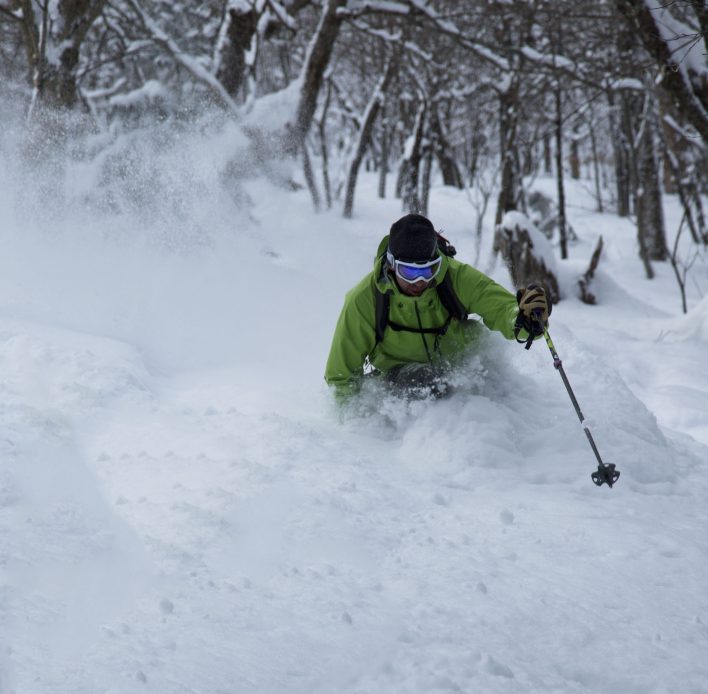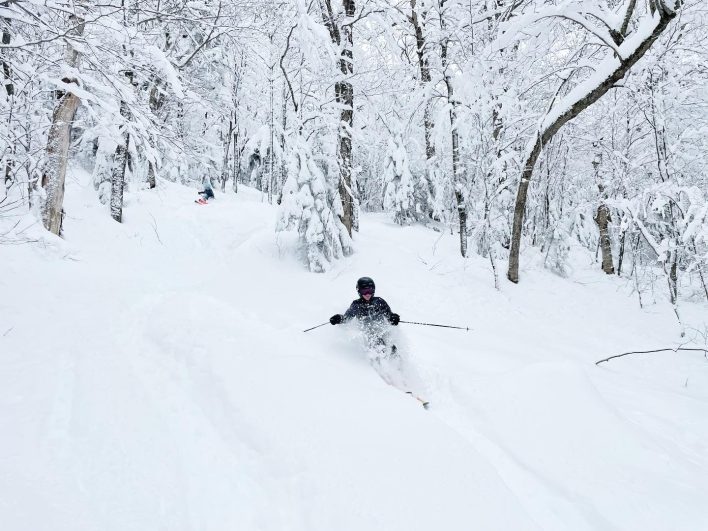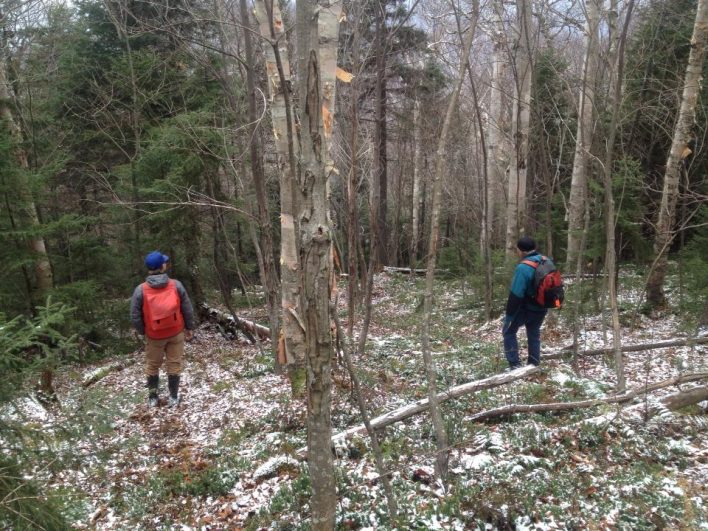On a Wednesday morning in March, Greg White rises early and drives up Vermont’s Route 73. Parking at an unassuming pullout just below the top of the Brandon Gap, White clicks into his skis and starts up the skintrack. He’s on the hunt for untracked powder.

White lives in Rochester—a town just east of the gap—and has backcountry skied for nearly 40 years. Few know the local ski history better than him. Like most of New England, the Brandon Gap is heavily forested. For decades, intrepid backcountry skiers picked their way through the trees. But today, that’s no longer necessary and White is one of the key players behind the recent development of Brandon’s now-popular designated backcountry ski zones.
“Our town, Rochester, was hit quite hard by Hurricane Irene in 2011,” he explains. In the wake of Irene, there were conversations about how to rebuild and revitalize the community. “Rochester is sort of between Killington and Sugarbush [on Route 100] so people do go through here all the time, but we wanted people to stop and take advantage of some of the recreational opportunities,” White says.
These conversations coalesced around backcountry skiing on Brandon Gap and the potential to develop this area for winter recreation. The work would be hard: There was brush to clear and trees to cut, ultimately with the goal of opening bigger glades. White and a group of dedicated skiers and community-minded folks began to map out areas that would make for good ski lines. In 2013, they started the Ridgeline Outdoor Collective to organize and support the project.
Route 73 winds over the Brandon Gap, connecting Rochester to the small town of Goshen on the west side of the Green Mountains. The surrounding land is all part of the Green Mountain National Forest.

There wasn’t a precedent for developing public access backcountry ski zones on U.S. Forest Service land, but the agency was willing to give it a go. Starting with an environmental impact assessment, they determined where and how land could be cleared in accordance with ongoing forest management and environmental regulations. With guidelines in place, the newly created Ridgeline Outdoor Collective was given the green light. In 2013, clearing began in earnest.
“[Our backcountry development proposal] was sort of a pilot project. It’s the first time in the U.S. that the Forest Service has allowed something like this,” White explains. “We worked closely with [them] to mark zones where the ski lines would be. The Forest Service didn’t want to call them trails because they didn’t want to create a ski area-type environment. They wanted it to be more open glades that would spread people out and lessen impact.”
Three years after they first began clearing, the Ridgeline Outdoor Collective created four backcountry zones: Goshen Mountain, Sunrise Bowl, No Name and Bear Brook.
“[It took] thousands of hours of volunteer work,” White explains. “We conducted work days where we put out a call for people to help. We would get 20 to 30 people from all over New England to spend the day or weekend with us helping out.”

While a large upfront effort established the ski zones, a dedicated group works to maintain the area each fall. Given how quickly small vegetation and underbrush grows in Vermont’s lush climate, this is no small feat. “[The ski zones] still require almost 600 hours of work per year to maintain,” White says. “But I like being out in the woods. The trail maintenance to me is great dryland training before winter comes.”
Once the first flakes of the season start flying, the massive effort is well-worth it. The glades fill in and snow tamps down any leftover underbrush.
Most of the lines offer around 1,000 vertical feet of skiing, which is long by East Coast standards. “There’s probably around 17,000 vertical feet of skiing in that area if you take all the lines that we created in four different zones,” White says. “So it’s quite a bit of skiing.”
Two designated trailheads offer access to all four zones. Though trails aren’t marked, there are dedicated, set skintracks for the ascents. “The skiing is pretty self-evident,” White says, “and it’s not just limited to the glades. When the snow depth is up, you can ski almost anywhere up there.”
“Over the last 10 years [the area has] really become pretty well known,” he adds. “Lots of people from all over New England and eastern Canada come down to ski here.” Despite the influx of people, overuse isn’t a major concern. “The area spreads people out,” he explains. “I’ve been up there with more than 30 cars and hardly seen anyone skiing. And if you’re really knowledgeable of the area you can always find fresh powder.”
Now a decade later, the trails continue to be well-maintained and loved. “We had an economic study done on the benefits of Brandon Gap for the Rochester community,” White says. “And [the skiing] really helped our local businesses out during the winter in particular.”
The success story of Brandon Gap has had ripple effects throughout the region. “Because of the success of developing backcountry ski zones, the Forest Service is open to [more projects like this],” White says. Granite Backcountry Alliance has developed more glades in New Hampshire and western Maine, and just last year the Ridgeline Outdoor Collective started work on clearing a skintrack in Vermont’s Chittenden Brook Drainage.

While skiing is the product of these projects, community is what keeps them alive. “The original reason for getting involved in this was to help our community,” White says. “It’s great to be out in the woods and create these areas that lots of backcountry enthusiasts can enjoy and it’s so neat to see what you’ve created. It’s amazing what you can get done when you get a few like-minded people who are willing to put the work in together.”
Even as Vermonters continue to bask in the warm August sun and slurp on perfectly swirled maple creemees, the air is tinged with the imminence of winter as days get shorter and nights cooler. Winter is just around the corner. Last week, White and a group of volunteers headed into the woods around the Brandon Gap to kick off the fall maintenance work for the coming season.
No one knows exactly what this coming winter has in store, but White knows that no matter what, he’ll be arcing fresh turns in the backwoods of Vermont as soon as there’s snow on the ground.
Interested in visiting? The Ridgeline Outdoor Collective offers lots of information on touring access and cleared lines through their website including downloadable Avenza maps and PDF files of the area. Paper maps are also available for sale at outdoor outlets and local businesses in the surrounding communities.
To read more stories from the untracked experience, pick up a copy of Backcountry Magazine, or subscribe.










Related posts: